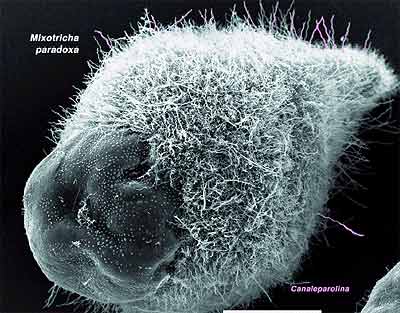Some of the most beautiful and biologically important symbioses are mutualistic in nature. For instance most of the shallow coral species form mutualistic symbioses with dinoflagellate algal species. The coral receives nutrition from the the photosynthesis of the algae and the algae receives a protected environment and nutrients obtained by the coral. This interaction has enabled coral reefs to be among the most productive of Earth's ecosystems. These ecosystems have a profound impact globally as sites of carbon dioxide absorption, energy production for larger oceanic ecosystems and as nurseries for many fish species.
Most animals have a diverse microbial flora within their digestive tracts. Humans, for example, have many mutually beneficial relationships with some of our intestinal microbiota. For instance, several species of Bacterioides and Escherichia are our principle source of vitamin K which is an essential factor involved in blood clotting. Other species have been shown to be important sources of some B vitamins, and recently one species of Bacterioides has been determined to be an essential component in the development of blood vessels of the small intestine.
Among all of the species known to science, none seem to stretch the boundaries of mutualism to the extent of that exhibited by the termites. In some termite species, the microbial flora (bacteria and protists) of their digestive tract amounts to as much as 50% of the individual's weight. Termite bodies are literally crammed full of various symbiotic organisms which are, in many cases, crammed full themselves with their own microbiota. To observe this firsthand, try this activity.
| |
Within the digestive tract of these termites is a diverse microbial world that has evolved along with the termites' ecologic role in the environment. Termites, like most animals, lack the enzymes necessary to break down the principle components of plant tissues: cellulose and lignin. How then do termites manage to survive on a diet of wood? Well, actually they don't, at least not directly. |
|
Termites are important decomposers of wood. |
 |
Termites, like most plants and animals, are composite organisms. The protist at left is just "one" of hundreds of thousands of microbes that live symbiotically within the termites digestive tract, and it is actually composed of at least 5 different organisms. The "hair-like" projections are actually several different species of spirochete and bacillus bacteria that seem to function in movement. Still other bacteria live within the protist cell, releasing energy from the food that it absorbs while other bacteria produce the enzymes necessary for digestion of the cellulose and lignin fibers that are the main components of wood. |
|
Within the termite live multitudes. |
| |
Some bacteria within a termite's digestive tract are involved in recycling the termite's wastes. Like all insects, termites eliminate toxic nitrogen containing wastes in the form of uric acid. Some of these bacteria actually breakdown the uric acid wastes and release the nitrogen back into the termite's "blood" in the form of readily usable amino acids. |
|
Bacteria associated with the termite digestive tract. |
Termites and their associated microbial partners have forced us to redefine our concept of the organism. Termites without their symbionts will quickly perish, as will humans without a critical portion of their intestinal flora. We can no longer look at life, multicellular or unicellular, as functionally independent species, as it has become ever more apparent that each species is, in fact, a complex, microbial ecosystem: a composite of multiple, interdependent parts.




